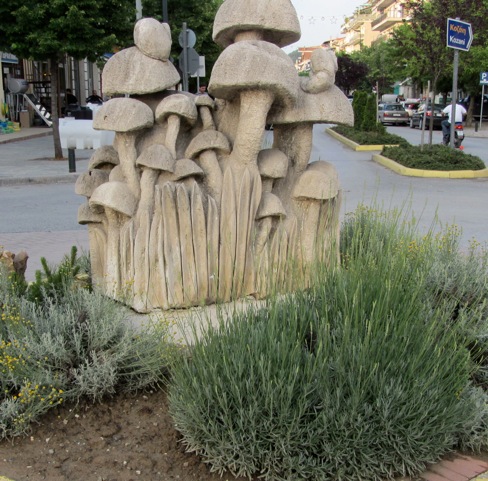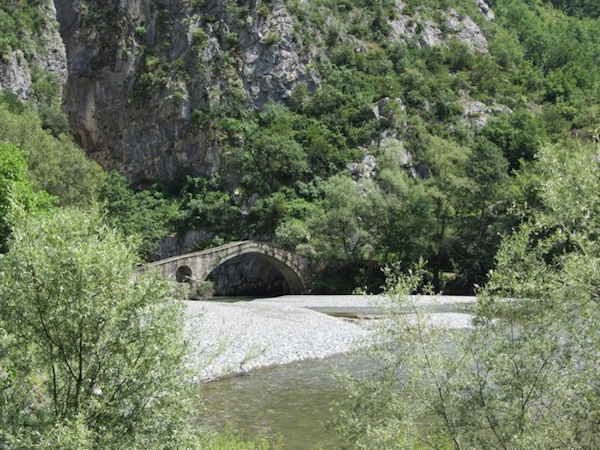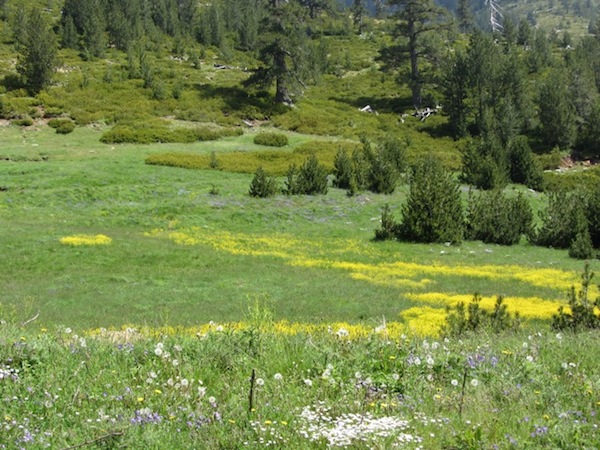Glories That Are Still Greek, III: Magic Mushrooms?
Eating Well Is The Best Revenge
by Diana Farr Louis
ATHENS Greece—(Weekly Hubris)—6/20/11—There is a saying here in Greece that suddenly makes sense: “Madness does not go to the mountains; it goes into people” (I trella den paei sta vouna; paei stous anthropous.). After a winter of strikes, protests, and what the newspapers call a “downpour of taxes,” we were being driven mad ourselves by frustration and anxiety, brigades of beggars at our stop lights, and high-end SUVs that don’t stop at all.
Greece is always a tad “touched,” even in the best of times, which is why I have always adored living here. As an old friend once said, “Without this element of craziness, Greece would be like Florida—for the newly-wed and the nearly dead.” He’d spent many years in the US and knew whereof he spoke.
The only solution, albeit temporary, to our malaise would be to get out of town and out of reach of the barrage of bad news. Was there a place where we could recharge our batteries, connect with the Greece of our memories and dreams?
There was indeed and it has the strange name of Valia Calda. Doesn’t sound Greek, does it? Valia Calda means Hot Valley in Vlach and the Vlachs, though residents of Macedonia and Epirus for almost 2,000 years, speak a Latinate language they trace back to their ancestors, Roman border guards who stayed behind when the empire split between Rome and Constantinople.
I’d never heard of Valia Calda until perhaps ten years ago. But now and again rumors of its extreme beauty would pique my curiosity. Hot Valley, which does not sound nearly as alluring, forms the heart of the Pindos National Park, one of Greece’s largest but least known sanctuaries. As to the temperatures of this Alpine plateau (1,400 m asl), they are only marginally warmer than the high peaks (above 2,000 m asl) that surround it. For all I know, the locals may have made up the name as an ironic joke. For unlike, say, Yellowstone Park, there are no geysers or hot springs here; just a tangle of icy rivers. And the winter snow doesn’t melt until mid-May.
To get to Valia Calda, we drove about seven hours northwest of Athens. Greece looked like Ireland must, dressed in myriad shades of emerald, roads framed by mini-explosions of bright yellow broom. Not a speck of the trash or rubble that so often disgraces Attica. Apart from the exception that proves the rule: an abandoned bathtub lurking in the woods where we stopped for a stretch.
Because Valia Calda itself is under strictest protection—like Delos, overnighting is forbidden—we’d arranged for a hotel in the nearest town, Grevena. It would be kind to say that Grevena is unprepossessing. Just a bedraggled village until the 1960s, the place has no “old” center with low stone or half-timbered houses like virtually everywhere else in northern Greece. Instead, it’s a collection of charmless five- and six-story, ill-matched apartment buildings.

In recent years, though, Grevena has added a twee touch: little fountains and planted squares with sculptures of wild funghi. Who knew? This is the mushroom capital of Greece. Shroom-foraging is a major occupation, along with wood-cutting, shepherding, game farming, and guiding groups into the National Park. Every other shop sells mushroom products—dried porcini, morels, chanterelles (the most common), but also mushroom-scented pasta, trahana, soups, and . . . jams. No accounting for taste, but Greeks probably have as many flavors for what they call spoon sweets as the Italians have for their gelati.
And every restaurant boasts glorious funghi recipes. We tried them fried, grilled, breaded, creamed; in pasta, pizza, omelettes, and stews. After three luscious meals, served with good to superior brousko, red barrel wine, Grevena’s aesthetically challenged architecture was forgotten and forgiven.
Besides, just five minutes outside town, we were in a rural utopia of wheat fields, small vineyards, handsome houses, tidy cobbled hamlets, and meticulously crafted stone bridges that arched like half moons above tumbling rivers.

This is the outer park, where traditional pursuits and buildings are permitted. Then, up we drove through woods of evergreen and leafy trees to a point where we could have seen Mt. Olympus had the visibility been good (ain’t that always the case?). There we met a path. Advertised by our guides as a “gentle stroll to Orliaka and the Mount of Eagles,” it proved to be a six-kilometer hike that lasted almost three hours. Some knees were trembling on the downhill stretch, but few complained.
The next day’s ramblings, in Valia Calda itself, were over flat meadows dimpled with molehills, through pines taller than Georgia’s, and beside trickling streams and plashing brooks.
On both walks, the rewards were infinite. Beside the sheer bliss of immersing ourselves in nature, we had a profusion of flowers, rare and familiar, to photograph; wolf tracks, a little brown snake, and a yellow-bellied toad to stare at; the sound of cuckoos chiming and woodpeckers drilling; and occasional sightings of deadly mushrooms—but no porcini, alas—thrusting the earth aside.
Our guides told us there were some 90 kinds of edible mushrooms to choose from among the more than 2,000 scattered in these forests. The boss, Apostolis (Tolis) Dianellos, said he’d been poisoned three times. But he remains an aficionado. Another guide said he’d collected 10,000 euros worth of morels on our home mountain, Pendeli, after the disastrous fires of 09. He sold them to Spain, city Greeks being a bit dubious about mushrooms, generally. Their loss. I was shocked—at the amounts and at the (farfetched, I hope) possibility that some pervert might set fires to collect morels, which apparently love newly-burnt woodlands. Most of all, I was truly peeved to learn that such shrooms had popped up in my back yard without my knowledge. I may become a fire-engine chaser.
But beautiful and soothing as Valia Calda was, it would not have been so completely satisfying without the company of our guides. All members of a society to preserve the park, they fed us information in digestible doses, told us dozens of tales about life in the forest, infected us with their passion and enthusiasm for their glorious wilderness. They were anything but gruff backwoodsmen, though, and their wit, charm, and intelligence made me think that cities no longer have a monopoly on “civilization.”
We know that madness doesn’t go to the mountains, it goes into people. Perhaps it spreads faster in cities. Meanwhile, though, sanity still resides in Greece’s mountains. Whether or not you’ve eaten magic mushrooms.

![]()
Author’s Note: This excursion was organized by the Mediterranean Garden Society (www.mediterraneangardensociety.org) and our guides were Overland (http://www.overland.gr/etairia_en.htm). For a glimpse of a few extraordinary mushrooms, go to www.manitari.gr. You may not be able to read the Greek, but the photos speak for themselves.